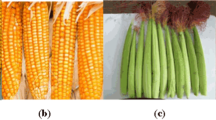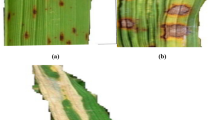Abstract
Classification of plant diseases is an important aspect of agriculture and this proposed methodology aims at identification, prediction and classification of corn leaf disease using AlexNet architecture with transfer learning methodology and AlexNet-Inception model. Different optimizers such as Stochastic Gradient Descent with Momentum, RMSprop and ADAM were employed in training the network. A 25-layer AlexNet model with transfer learning approach was modelled to sort the dataset into 4 classes, healthy, blight, common rust, and grey leaf spot. Both the networks were trained with multiple hyper parameter configurations with various learning rates, mini batch sizes, and training-to-test ratios. The modified AlexNet-Inception network performs multiple parallel convolution operations with different sizes of filters 1 × 1, 3 × 3 and 5 × 5 and average pooling on the output of 2D max pooling layer of AlexNet layer and these outputs are concatenated to produce one output. Thus the network gets progressively wider, not deeper and the computational cost is reduced and thereby avoiding the vanishing gradient problem. The detailed analysis of the features that were prioritized by AlexNet and AlexNet-Inception network for the classification of test images were validated with LIME and Grad-CAM technique and it was proved that AlexNet-Inception network outperforms the AlexNet transfer learning approach and the accuracy achieved were 98.91% for the ideal learning rate setting of 0.0001. The trials’ findings indicate that the algorithm is more precise and quicker than conventional AlexNet model, providing a novel method for detecting abnormalities in maize plants. In a number of agricultural industries, this suggested effort can be utilized to implement in real time applications.












Similar content being viewed by others
Explore related subjects
Discover the latest articles and news from researchers in related subjects, suggested using machine learning.Data availability
Data that support the findings is available from the corresponding author upon reasonable request.
Abbreviations
- ADAM:
-
Adaptive Moment Estimation
- CNN:
-
Convolutional Neural Network
- DNN:
-
Deep Neural Network
- DFCANet:
-
Double Fusion block with Coordinate Attention Network
- F-CNN:
-
Faster-CNN
- FCN:
-
Fully Convolutional Network
- FP:
-
False Positive
- FN:
-
False Negative
- Grad-CAM:
-
Gradient-weighted Class Activation Mapping
- LIME:
-
local interpretable model-agnostic
- LDSNet:
-
Lightweight dense-scale network
- LSTM:
-
Long Short Term Memory
- RAM:
-
Random Access Memory
- RECALL:
-
Repairing Errors in Computer Aided Language Learning
- R-FCN:
-
Region-based FCN
- R-CNN:
-
Region-based Convolutional Neural Networks
- ROI:
-
Region of Interest
- RMSProp:
-
Root Mean Squared propagation
- ResNet:
-
Residual Network
- SGDM:
-
Stochastic Gradient Descent with Momentum
- TP:
-
True Positive
- VGG:
-
Visual Geometry Group
- YOLOv3:
-
You Only Look Once, Version 3
- y :
-
True Output
- y^ :
-
predicted output
- v t :
-
(Momentum)
- η :
-
momentum factor
- α:
-
Learning Rate.
- W old :
-
Previous Weight.
- \(\frac{\partial loss}{\partial {W}_{old}}\) :
-
Gradient – Derivative of loss with respect to weight
- γ:
-
Previous Gradient
- W t :
-
Weight at any instant of time t
- W t − 1 :
-
Weight at any instant of time t-1
- ϵ :
-
Constant – Stopping Criteria
- θ:
-
Objective Function
- m t :
-
Moment at time t
- β 1 and β 2 :
-
(Constant)
- \(\hat{\ {m}_t}\) :
-
Updated value of first moment
- \(\hat{v_t}\) :
-
Updated value of Second moment
References
Amara, J, Bouaziz, B, Algergawy, A (2017) A deep learning-based approach for banana leaf diseases classification. In Gesellschaft für Informatik
Arora J, Agrawal U, Sharma P (2020) Classification of Maize leaf diseases from healthy leaves using Deep Forest. J Artif Intell Syst 2(1):14–26. https://doi.org/10.33969/ais.2020.21002
Arroyo, JA, Gomez-Castaneda, C, Ruiz, E, Munoz de Cote, E, Gavi, F, Sucar, LE (2017) UAV technology and machine learning techniques applied to the yield improvement in precision agriculture. 2017 IEEE Mexican Humanitarian Technology Conference (MHTC)
Balasubramanian K (2021) Performance of convolutional neural networks optimizers: an extensive evaluation on glaucoma prediction. Int J Comput Intell Stud 10(4):217–231. https://doi.org/10.1504/ijcistudies.2021.10044487
Chen Y, Chen X, Lin J, Pan R, Cao T, Cai J, Yu D, Cernava T, Zhang X (2022) DFCANet: A novel lightweight convolutional neural network model for corn disease identification. Agriculture 12(12):2047. https://doi.org/10.3390/agriculture12122047
Da Rocha, Erik L, Rodrigues L, Mari JF (2020) Maize leaf disease classification using convolutional neural networks and hyperparameter optimization. In: Anais do XVI Workshop de Visão Computacional, pp 104–110
Daneshwari, AN, Basavaraju, DR (2022) Corn leaf image classification based on machine learning techniques for accurate leaf disease detection. Int J Electric Comput Eng, 12(3)
Devi KG, Rath M, Linh NTD (2020) Artificial intelligence trends for data analytics using machine learning and deep learning approaches. CRC Press
Ha JG, Moon H, Kwak JT, Hassan SI, Dang M, New Lee O, Park HY (2017) Deep convolutional neural network for classifying fusarium wilt of radish from unmanned aerial vehicles. J Appl Remote Sens 11(04):1. https://doi.org/10.1117/1.jrs.11.042621
Hanson, AMGJ, Joel, MG, Joy, A, Francis, J (2017) Plant leaf disease detection using deep learning and convolutional neural network. Int J Eng Sci
Hidayat A, Darusalam U, Irmawati I (2019) Detection of disease on corn plants using convolutional neural network methods. Jurnal Ilmu Komputer Dan Informasi 12(1):51–56. https://doi.org/10.21609/jiki.v12i1.695
Kussul N, Lavreniuk M, Skakun S, Shelestov A (2017) Deep learning classification of land cover and crop types using remote sensing data. IEEE Geosci Remote Sens Lett A Publ IEEE Geosci Remote Sens Soc 14(5):778–782. https://doi.org/10.1109/lgrs.2017.2681128
Liu B, Zhang Y, He D, Li Y (2017) Identification of apple leaf diseases based on deep convolutional neural networks. Symmetry 10(1):11. https://doi.org/10.3390/sym10010011
Lu Y, Yi S, Zeng N, Liu Y, Zhang Y (2017) Identification of rice diseases using deep convolutional neural networks. Neurocomputing 267:378–384. https://doi.org/10.1016/j.neucom.2017.06.023
Mohanty SP, Hughes DP, Salathé M (2016) Using deep learning for image-based plant disease detection. Front Plant Sci 7:1419. https://doi.org/10.3389/fpls.2016.01419
Ren C, Kim DK, Jeong D (2020) A survey of deep learning in agriculture: techniques and their applications. J Inf Process Syst 16(5):1015–1033
Ristorto, G, Mazzetto, F, Guglieri, G, Quagliotti, F (2015) Monitoring performances and cost estimation of multirotor unmanned aerial systems in precision farming. 2015 international conference on unmanned aircraft systems (ICUAS)
Rothe, PR, Kshirsagar, RV (2015) Cotton leaf disease identification using pattern recognition techniques. 2015 international conference on pervasive computing (ICPC)
Sheikh MH, Mim TT, Reza MS, Rabby ASA, Hossain SA (2019) Detection of maize and peach leaf diseases using image processing. In: 2019 10th international conference on computing, Communication and Networking Technologies (ICCCNT), pp 1–7
Sibiya M, Sumbwanyambe M (2019) A computational procedure for the recognition and classification of maize leaf diseases out of healthy leaves using convolutional neural networks. AgriEngineering 1(1):119–131. https://doi.org/10.3390/agriengineering1010009
Subramanian M, Narasimha Prasad LV, Ve S (2022) Hyperparameter optimization for transfer learning of VGG16 for disease identification in corn leaves using Bayesian optimization. Big Data 10(3):215–229. https://doi.org/10.1089/big.2021.0218
Yallappa, D, Veerangouda, M, Maski, D, Palled, V, Bheemanna, M (2017) Development and evaluation of drone mounted sprayer for pesticide applications to crops. 2017 IEEE global humanitarian technology conference (GHTC)
Yu H, Liu J, Chen C, Heidari AA, Zhang Q, Chen H, Mafarja M, Turabieh H (2021) Corn leaf diseases diagnosis based on K-means clustering and deep learning. IEEE Access: Pract Innov Open Solutions 9:143824–143835. https://doi.org/10.1109/access.2021.3120379
Zeng W, Li H, Hu G, Liang D (2022) Lightweight dense-scale network (LDSNet) for corn leaf disease identification. Comput Electron Agric 197(106943):106943. https://doi.org/10.1016/j.compag.2022.106943
Zhang X, Qiao Y, Meng F, Fan C, Zhang M (2018) Identification of maize leaf diseases using improved deep convolutional neural networks. IEEE Access: Pract Innov Open Solutions 6:30370–30377. https://doi.org/10.1109/access.2018.2844405
Author information
Authors and Affiliations
Corresponding author
Ethics declarations
Conflict of interest
The authors declare no conflict of interest and no potential funding.
Additional information
Publisher’s note
Springer Nature remains neutral with regard to jurisdictional claims in published maps and institutional affiliations.
Rights and permissions
Springer Nature or its licensor (e.g. a society or other partner) holds exclusive rights to this article under a publishing agreement with the author(s) or other rightsholder(s); author self-archiving of the accepted manuscript version of this article is solely governed by the terms of such publishing agreement and applicable law.
About this article
Cite this article
K, G.D., Balasubramanian, K. & C, S. Feature analysis and classification of maize crop diseases employing AlexNet-inception network. Multimed Tools Appl 83, 26971–26999 (2024). https://doi.org/10.1007/s11042-023-16467-7
Received:
Revised:
Accepted:
Published:
Issue Date:
DOI: https://doi.org/10.1007/s11042-023-16467-7




